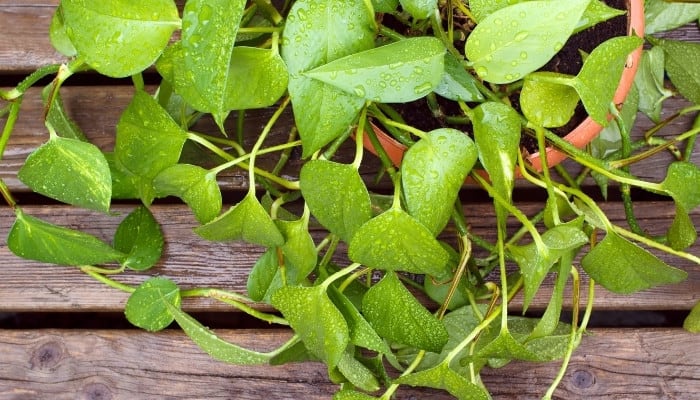The modest pothos plant introduces a splash of wilderness to bland areas via its rapid-developing vines of heart-shaped leaves.
With color varieties of both solid green and marbled white and yellow, this plant offers the magic combination of easygoing care and exotic looks – making it accessible to even the most disaster-prone plant keeper.
How do you care for pothos? Pothos plants don’t require intensive maintenance to thrive. Simply provide an organic soil that drains well, 60-80°F temperatures, 50-70% humidity, and bright, indirect light. Water only when the first few inches of soil is dry, and apply a liquid fertilizer every three months.
Caring for Pothos: Basic Guidelines
Pothos plants are also known as Devil’s ivy, but apart from the toxic content of their sap, there is nothing devilish about their day-to-day care.
This laid-back houseplant can prosper for many years if you stick to the fundamental care needs.
We’ll take you through the basics, plus take a look at different pothos varieties, how to deal with pests, and more.
Complete Care Guide for Pothos
This classic houseplant was first documented in 1880 by Belgian botanist Jean Jules Linden and French horticulturist Édouard André who named it Pothos aureus (the Greek word pothos meaning “longing” and the Latin word aureus meaning “golden”)
It has since been reclassified multiple times in the last century to accurately describe its growth habit, but the original description is still apt in categorizing the pothos – a determined fast-growing vine with a longing to explore its surroundings and seek out light.
Pothos at a Glance
- Plant Type: Evergreen vining perennial
- Scientific Name: Epipremnum aureum
- Average Height: 10-20 feet
- Average Width: 3 feet
- Growth Rate: Slow
- Produces Flowers: No
- Common Pests: Thrips, mealybugs
- Life Expectancy: 5-10 years
- Difficulty of Care: Low
What To Do When You First Get Your Pothos Plant
- See if it’s thirsty – Check the top few inches of soil with your pinkie, and if it comes up completely dry, give it a drink. If it’s damp, give it time to dry up again as soggy soil is a no-no.
- Check for pests – The humid care conditions this plant needs can attract critters from time to time, so check the soil and foliage, and remove any you find to give your pothos a good start (see Common Pests below).
- Decide how to display it – Pothos will flourish and look stunning whether you let them cascade from a high shelf or train them to climb vertically along a window frame or place them in a pot with a support pole.
Ideal Soil for Pothos
The good news is pothos won’t require specialized nutrient-rich soil to thrive.
America’s No.1 organic gardening company Back to the Roots suggests keeping things simple by using:
“an organic potting soil that’s light and provides proper drainage like equal parts peat moss, shredded bark, and compost, as pothos don’t enjoy having ‘wet feet’.”
Pothos Water Requirements
Put simply, you’ll only need to water your pothos when the top layer (2 inches) of soil dries.
This may be once a week during summer and once every two weeks during colder months. This is a hardy plant, and less is definitely more to prevent rotting roots and fungal issues.
Pothos Lighting Needs
As long as they are not placed in direct sunlight, pothos plants will do well.
They can tolerate partial shade when grown outdoors and are suited to most areas of the home that get bright, diffused sunlight.
While fine in low-light conditions, variegated (patterned) pothos varieties can become dull in too much shade.
Ideal Temperature Range for Pothos
Keeping things above 50°F (10°C) is necessary, but 60-80°F (15-26°C) will be an ideal range to mimic the conditions of their native Southeast Asia.
Try to keep them clear of any drafts and cooler areas in your home.
Ideal Humidity Level for Pothos
Around 50-70% will be perfect, though pothos plants can tolerate drier conditions (except for Manjula and Marble Queen pothos varieties as their variegated foliage can fade and turn crispy outside this range.)
You can either use a humidifier (like this whisper-quiet one) to help you set the right levels or naturally increase humidity by placing your pothos near other plants or making a pebble tray (here’s how).
Best Location for Pothos
Bathrooms can be ideal to hit the humidity and temperature target – just ensure it isn’t in a spot to get soaked.
Low-lit offices, kitchens, and bedrooms can also be suitable as long as they meet the required conditions.
Pothos Growth Habits
Pothos plants grow in a climbing or trailing vine habit that reaches for the sun in its filtered rain forest habitat and reaches for your ceiling if you train it to!
Fertilization Type & Schedule for Pothos
These plants can do just fine without fertilizer, but if you wish to give their growing vines a boost, use a liquid houseplant fertilizer once every three months, and dilute the solution to half strength.
Signs of Nutrient Deficiency
Slow growth, brown leaf tips, or a generally droopy and tired appearance can all point to a lack of nutrients.
Overwatering and over-fertilizing are discouraged for this reason as the roots can begin to take in fertilizer salts instead of nutrients, and soggy soil can gradually damage root areas altogether.
Pruning Pothos
Pruning won’t be necessary if you prefer long, trailing pothos, but you can control growth from your hanging basket or potted plant by trimming longer stems above the growth node where the leaves meet the main vine with clean pruning shears.
Does Pothos Produce Flowers?
While mature plants produce subtle white flowers in the wild, it’s rare for pothos to bloom indoors.
They are grown and loved for their cascading greenery, not really as a flowering houseplant.
Is the Pothos Plant Toxic?
The sap from pothos plants can irritate those with sensitive skin, and the plant can be toxic to pets and children when ingested.
Pothos plants contain calcium oxalates, which may cause vomiting and oral irritation so take care to place them out of reach.
Pothos Propagation
To build up a little collection, you can propagate (multiply your pothos plants from the original mother plant) using root dividing and stem cutting methods.
As the simplest and least messy of the two, we’d recommend using the stem cutting propagation method:
1. Cut a Stem Section With at least 2 Leaves Attached
Cut a 4-6 inch section of healthy stem from the main vine, ensuring it has at least two leaves attached.
Use sterilized pruning shears to prevent infection, and cut the stem off just below a leaf node.
2. Place the Stem Cuttings in Water for 1-2 Months
Fill a small clear vase or jam jar with room temperature water, and place your new pothos stem cutting in it.
Place it in indirect sunlight, and change the water every 2-3 weeks. After 1-2 months, roots will begin to develop.
Propagation should be carried out in spring/summer for best results, otherwise roots may fail to develop fast or at all.
3. Plant Well-Rooted (3 Inch Root) Stem Cuttings in Soil
Once the roots are around 3 inches long, plant the stem cuttings in a pot of fresh soil (plant multiple stem cuttings together in the same pot for lush, bushy results).
It helps to prepare a pot beforehand with 1/3 of your organic soil mix to secure the stems before adding the rest of the soil.
4. Water New Pothos Offspring Plant & Place in Ideal Conditions
Water your newly propagated mini pothos plant, and set it up in the same conditions as its parent plant (place it immediately next to its mother pothos for increased humidity).
Check that the new plant drains well through its pot holes after each watering, and allow a few weeks for noticeable growth as all this rehoming can cause stress.
Repotting Pothos
Your pothos plant will routinely need to be moved to a larger pot as the roots grow.
It will also benefit from being re-planted in fresh soil every once in a while throughout its life too.
When To Repot Pothos
Repotting into a larger pot should be done every two years or so as the roots expand within the pot (become rootbound) and begin poking beneath the drainage holes.
Even if your ideal care regimen for your pothos hasn’t changed, you may notice the leaves drooping after a couple of years in the same pot, which means it could benefit from being in fresh soil.
Signs That It’s Time To Repot
- Leaves drooping even with good care
- Roots are expanding within the pot
- Roots are poking out beneath drainage holes
How To Repot Pothos
1. Fill a New Larger Pot 1/3 Full With Well-Draining Organic Soil
Prepare a larger plant pot (at least 2 inches wider than your current one) by filling it 1/3 of the way with organic soil medium.
If your old soil mix hasn’t been draining well, this is a good opportunity to upgrade your recipe with drainage components such as vermiculite or coconut fiber to help aerate the soil.
2. Remove the Plant From Its Container Pot & Examine the Roots
Slide your pothos plant out of its current pot and gently brush off the existing soil until the roots are exposed.
The roots should feel firm and appear cream colored, but if they are black and mushy, your pothos has developed root rot.
In some cases, you can simply trim off diseased sections with a sharp sterile knife and repot the remaining healthy roots.
However, if the rot is widespread, grower and author of the Gardener’s Path blog Rose Kennedy advocates discarding the plant altogether:
“it’s ruthless, but pothos are affordable to buy new, especially in lieu of replacing the soil, the pot and having to buy a new plant anyway in a few weeks.”
3. Re-Plant Your Pothos in Fresh Soil & Water It Generously
Ensuring only healthy roots remain, plant your pothos into its new larger pot, and add in the remaining soil, patting down the surface gently so it’s secured.
Water it well, and check that it drains properly before putting it back in its usual spot (or a new area of suitable light and humidity levels).
Pothos Common Problems & Solutions That Work
Pothos Common Pests
Pothos plants are hard to kill, but remaining vigilant about certain pesky insects living off the leaves can help the foliage stay looking good and growing strong:
Thrips (Thunder Flies)
- Signs of Trouble – Silvery streaks on foliage that turn brown, small brown holes on leaves.
- Solution – Agriculturist from Garden for Indoor blog Arifur Rahman suggests “spraying with neem oil or horticultural oil as these contain pyrethrins which are low-impact on your pothos but target the nervous system of insects.” Try this organic neem for best results.
- Prevention – Place sticky traps near plant, and ensure humidity isn’t too low.
Mealybugs
- Signs of Trouble – Clusters of furry white “cotton-wool” looking woodlice, sticky honeydew residue on foliage.
- Solution – Moisten a cotton ball with rubbing alcohol and wipe affected areas.
- Prevention – Pick off mealybug clusters by hand, or flush plant pot in shower of lukewarm water periodically.
Pothos Common Diseases
Though tough and tolerant to some neglect, pothos plants can suffer bacterial infections in their foliage and roots if incorrect care (namely overwatering) persists:
Leaf Spot Fungus
- Signs of Trouble – Water-soaked lesions on leaves surrounded by yellow rings.
- Solution – Prune mildly damaged leaves showing signs. “When centers of these water-soaked spots fall out, the damage is too widespread and the infected plant should be discarded,” according to professor of plant pathology at Penn State University Gary W. Moorman.
- Prevention – Ensure light conditions are not too low, allow plant to dry between watering, and check the soil mix is draining well.
Root Rot
- Signs of Trouble – Yellowing leaves, black and mushy roots.
- Solution – Trim diseased sections, and repot in fresh soil, preferably treated with organic fungicide, like this natural one.
- Prevention – Plant blogger Rose Kennedy advises: “always use sterile potting mix with pothos, never dirt from outside or from another discarded plant.”
Other Common Problems
Without the right environmental conditions, pothos plants can commonly display changes in their foliage, but this shouldn’t be a cause for concern if they are detected early.
Yellowing Foliage
- Signs of Trouble – Yellow middle leaves and higher (yellowing on older leaves near the soil is natural as they shed and make way for new growth).
- Solution – Prune back affected leaves, and allow top soil layer to dry out in between watering.
- Prevention – Place plant in brighter light conditions, and reduce watering frequency.
Drooping Leaves
- Signs of Trouble – Wilted, limp foliage.
- Solution – Place a water saucer under the pot’s drain holes to let it soak for 45 minutes as drooping can point to dehydration.
- Prevention – Ensure soil is consistently moist (not left to remain soggy or overly dry), and increase humidity with a pebble tray or regular misting.
Popular Pothos Varieties
Golden Pothos: Appearance & Care
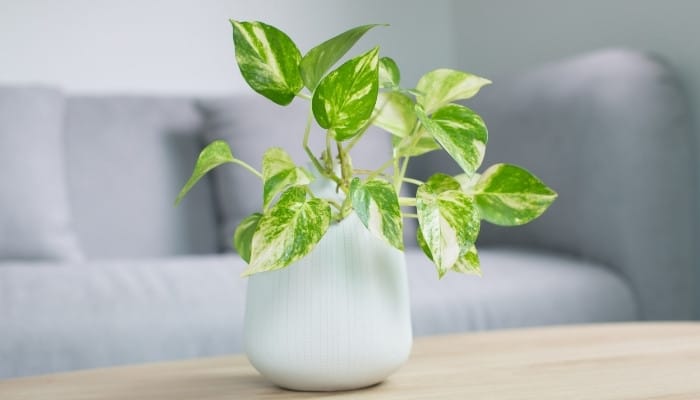
This is a low-maintenance, fast-growing vine with variegated green-and-yellow heart-shaped leaves.
It can reach 10 feet long and will favor a climbing trellis or cascading hanging basket in which to grow.
It will require 50% humidity or more and 60-80°F to thrive, as well as bright filtered sunlight and twice monthly fertilizer.
Neon Pothos: Appearance & Care
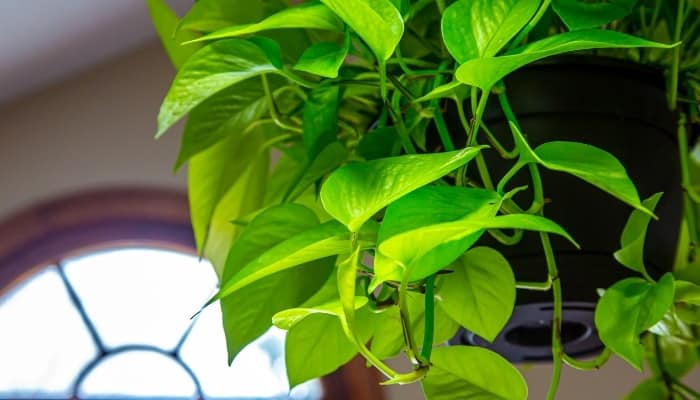
The neon pothos has bright-green glowing leaves and stems and can acquire a height of 5 feet without management.
It can tolerate low light conditions and will thrive in evenly damp soil and temperatures of 70-90°F.
Bathrooms are recommended to meet its high humidity needs, and weekly misting is encouraged.
Marble Queen Pothos: Appearance & Care
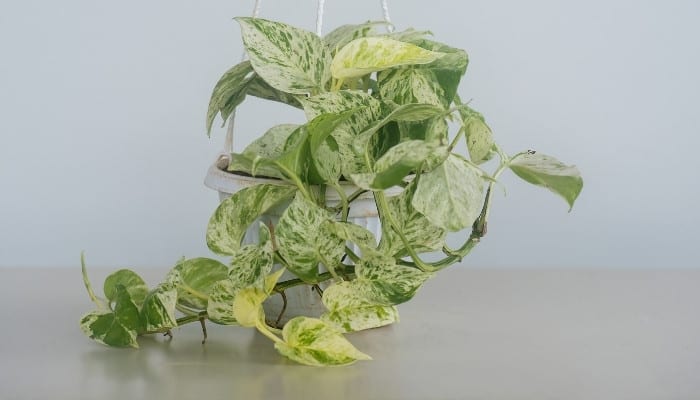
Marble queen pothos is an attractive variegated trailing vine of green-and-white leaves that favors bright, dappled light to prevent pattern fade.
It responds well to weekly watering but can tolerate less and thrives in temperatures between 65-85°F and at least 40% humidity.
It’s often grown on a high shelf to cascade to its max length of 5 feet.
Jessenia Pothos: Appearance & Care
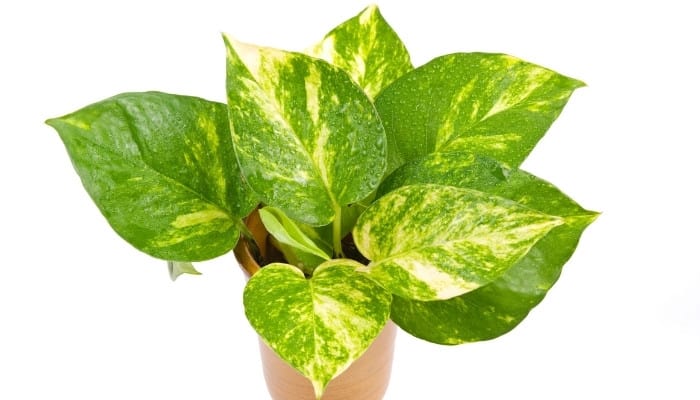 This pothos features large lime-green and darker variegated leaves and can reach 10 feet indoors or 30 feet in the wild.
This pothos features large lime-green and darker variegated leaves and can reach 10 feet indoors or 30 feet in the wild.
It has a high tolerance for varied lighting but diffused is ideal. It can withstand low temperatures of 55°F, though 70°F is recommended.
Humidity levels should be above 50%, and once-monthly fertilizer is encouraged.
Manjula Pothos: Appearance & Care
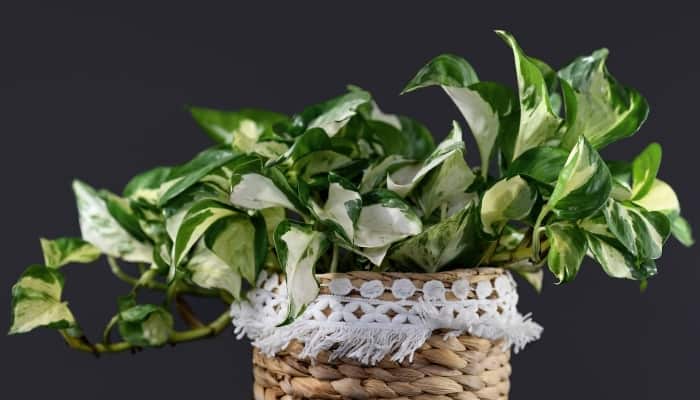
Manjula pothos leaves are curly with variegated swirls of white, yellow, and green. It can tolerate three-week watering intervals and will need indirect sunlight to preserve its foliage pattern.
Temperatures between 70-90°F will be ideal, and high humidity levels are best. Its ivy-like tendrils favor a hanging basket display.
See our full guide for the lovely Manjula here.
Jade Pothos: Appearance & Care
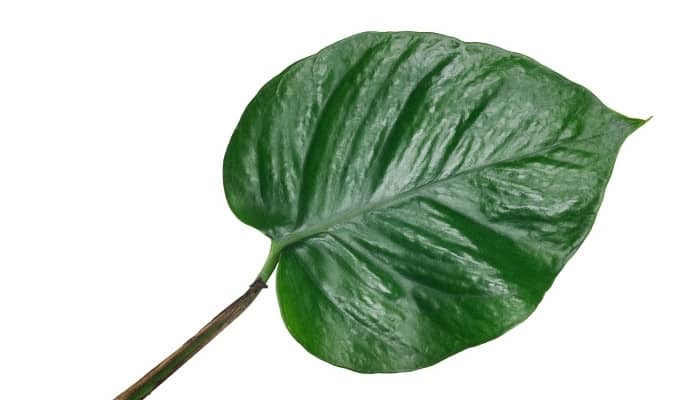
This fast-growing pothos features solid emerald-green leaves and can grow to be 10 feet plus indoors. It will benefit from regular pruning to prevent leggy stems and can tolerate low light conditions.
Keep it in a temperature range of 65-85°F, and place it in a bathroom or similarly humid conditions for best results.
Pothos Common Questions
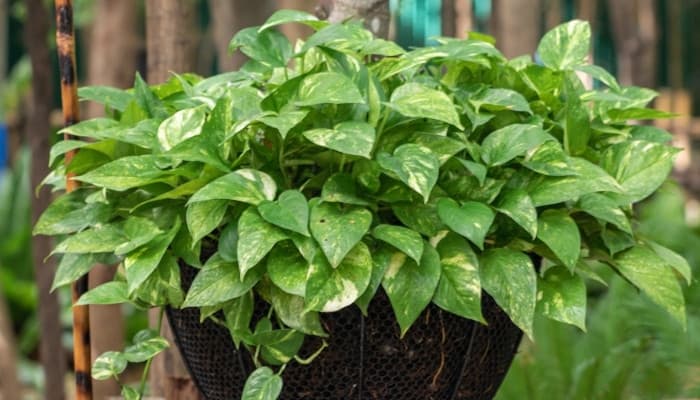
What Is the Fastest Growing Pothos?
Variegated pothos plants typically grow slower than solid color pothos varieties due to their lower chlorophyll content, so fast-growing pothos include the jade and neon subspecies.
Generally, though, all pothos plants grow at a moderate rate with great care and fertilizer.
How Many Different Types of Pothos Are There?
According to Kew Science, there are 47 known types of pothos.
From the original pothos plant “12 cultivations have become popular indoor plants due to decorative value,” notes author of Elements of Garden Design Adriano Bulla, “including the Pearls & Jade pothos, Cebu blue, and the Silver or ‘Satin’ pothos.”
Do All Pothos Climb?
All pothos plants are natural climbers in the wild since they anchor aerial (above-ground) roots to trees and branches in their native habitat.
When grown indoors pothos plants will adapt to their surroundings and spill horizontally over their pot, but they can be trained to climb (here’s how) with the assistance of moss poles or bamboo canes.
How Long Do Pothos Live?
“Healthy pothos plants should live up to 10 years” according to Keria Baron of the online houseplant guide The Happy Sprout.
While resilient to neglect, its lifespan will shorten with long-festering fungal infections, incorrect environmental conditions or allowing algae to form in old water during propagation.
3 Key Tips for Success With Pothos
1. Rotate Your Pothos Regularly To Prevent Lopsided Stem Growth
Your pothos plant will determinedly head for the light even in low-lit conditions, but you can still do your bit to help each stem look its best by rotating the pot now and then.
If keeping your pothos in a stand-alone pot or hanging basket, turn it every few weeks to prevent one side from growing unevenly.
2. Flush Fertilizer Residue Out of the Soil Every 6 Months
Remember that pothos plants largely cope well without fertilizer, but if you’re going to feed it regularly, just know that salt residue in the soil will eventually feed chlorine and sodium to the roots if left to build up.
Run room temperature water through the soil twice yearly to drain these toxins out.
3. Try the Switch to Distilled Water to Reduce Impurities
Help prevent further toxicity buildup in your pothos by giving it the best quality drinking water.
As a hardy plant, pothos should be fine when watered with tap water, but your local water source may have chemical traces. If this is the case, try using distilled water to encourage better growth.
Conclusion
To summarize, the pothos plant is a very forgiving houseplant that can be displayed in versatile ways as it adapts well to climbing supports or hangs in waterfall-like fashion from shelves and hanging baskets.
Variegated pothos varieties will need slightly more attention to prevent pattern fade, but all in all, this easy-going plant species can prosper for years so long as environmental conditions don’t stray too far from the recommended settings.
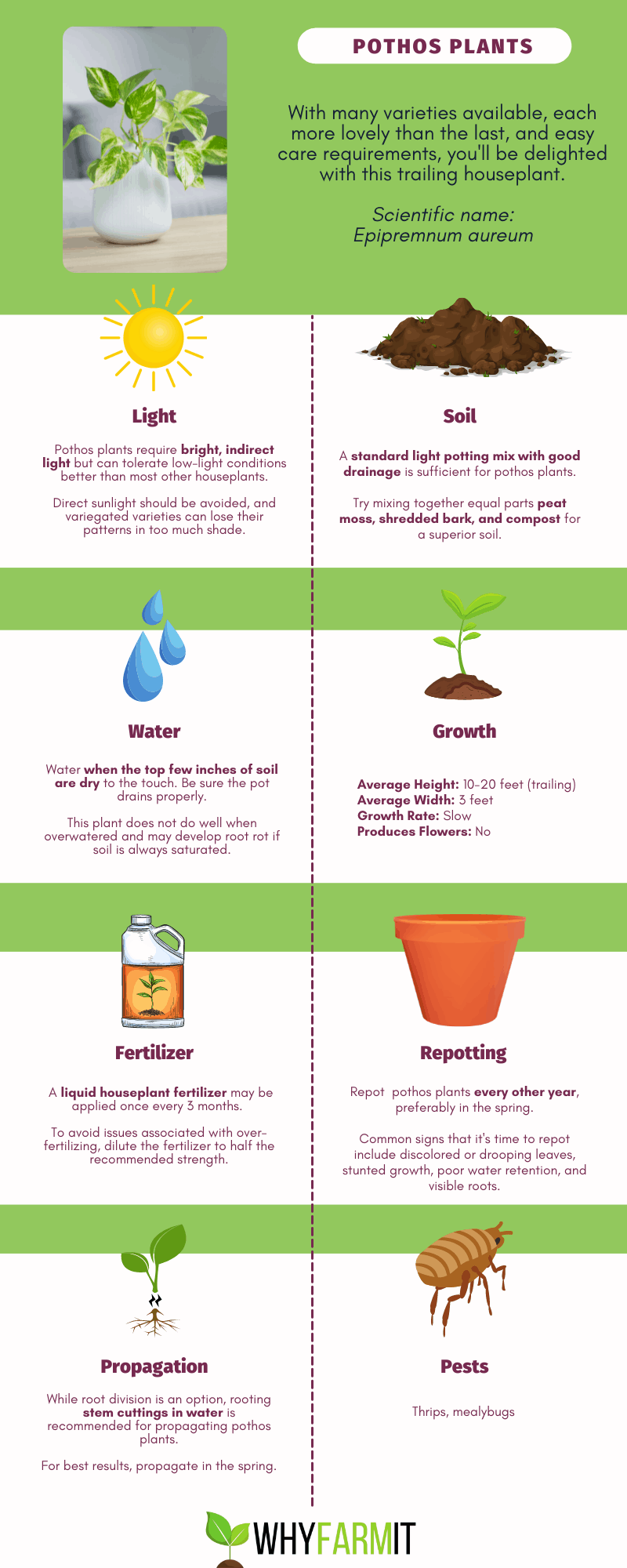
Sources:
https://plantcaretoday.com/pothos-soil.html
https://www.gardeningknowhow.com/houseplants/pothos/pothos-plant-care.htm
https://blog.backtotheroots.com/2021/03/02/pothos-plant-care/
https://www.proflowers.com/blog/pothos-plant-care
https://extension.psu.edu/pothos-diseases
https://www.masterclass.com/articles/pothos-plant-care-guide
https://planethouseplant.com/plant-profile-how-to-grow-pothos/
https://gardenforindoor.com/how-to-get-rid-of-bugs-on-pothos/
https://gardenerspath.com/plants/houseplants/grow-pothos/
https://www.ohiotropics.com/2020/06/16/pothos-not-rooting/
https://bloomscape.com/common-issue/why-are-the-leaves-on-my-pothos-drooping/
https://wcsp.science.kew.org/qsearch.do;jsessionid=F9EE3490F09F79B2EAF3F9D7DA164811.kppapp05-wcsp
https://www.epicgardening.com/golden-pothos-devils-ivy/
https://plantophiles.com/plant-care/neon-pothos/
https://leafyplace.com/marble-queen-pothos/
https://plantcaretoday.com/jessenia-pothos.html
https://indoorhomegarden.com/manjula-pothos-care/
https://plantcaretoday.com/jade-pothos.html
https://www.gardeningknowhow.com/garden-how-to/watering/using-distilled-water-on-plants.htm

